Nexus 7 (2013) - Mini Review
by Brian Klug on July 27, 2013 12:54 AM EST- Posted in
- Tablets
- Snapdragon
- Qualcomm
- Android
- Mobile
- APQ8064
- Nexus 7
- Android 4.3
The real highlight of the new Nexus 7 is of course the much higher resolution display. At 1920x1200 the Nexus 7 is now the highest resolution 7-inch tablet. This new IPS panel is made by JDI (Japan Display Inc) and boasts better viewing angles, 30 percent more gamut than the previous one, and of course better dot pitch of 323 PPI. Alongside that the new Nexus 7 also doesn’t have the always-on dynamic brightness and contrast (NVIDIA Prism / smartdimmer) that many including myself found frustrating with the original Nexus 7. On the new version the equivalent functions are enabled only during full screen video playback. This is a huge improvement since with the feature enabled on the previous Nexus 7 I always felt that greens were undersaturated and some dynamic range clipped.
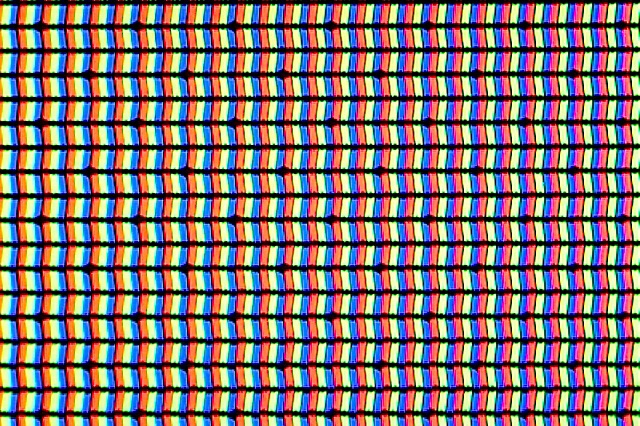
I did a lot of asking around about how Google calibrates its panels, and was told that in the case of the Nexus 7 there are two stages. The first is the calibration done by JDI on the panel at a high level, the second is an additional calibration at time of manufacture, per device. This sort of thing is relatively standard, but I’ve always been curious about what stages cost extra money – certainly it’s a baseline expectation for the panel supplier to supply a close-enough LUT, but getting Delta E even lower I’m told requires additional expenditure.
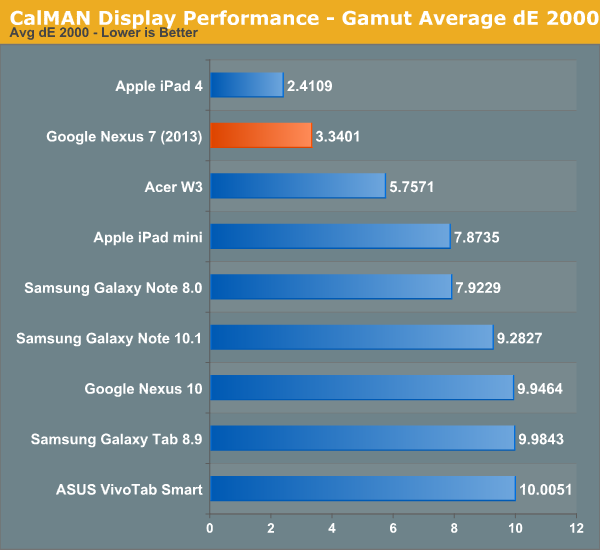
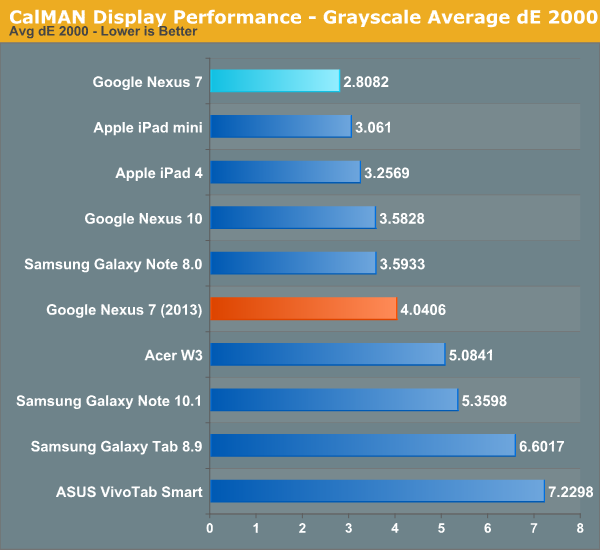
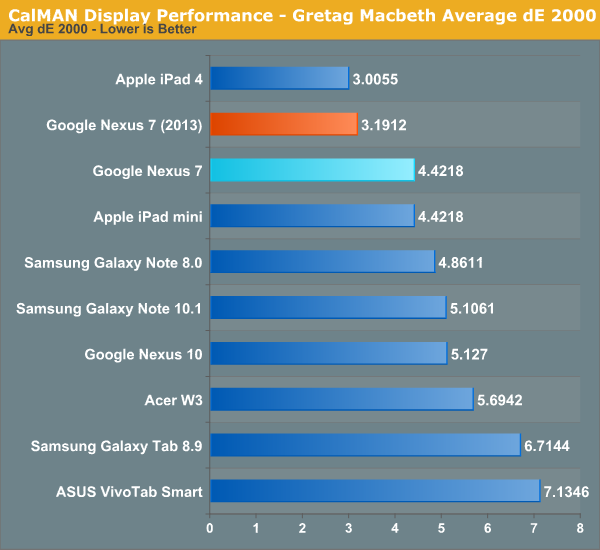
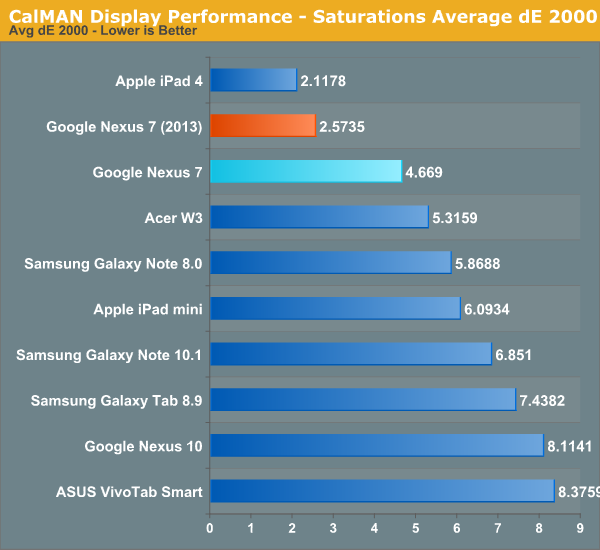
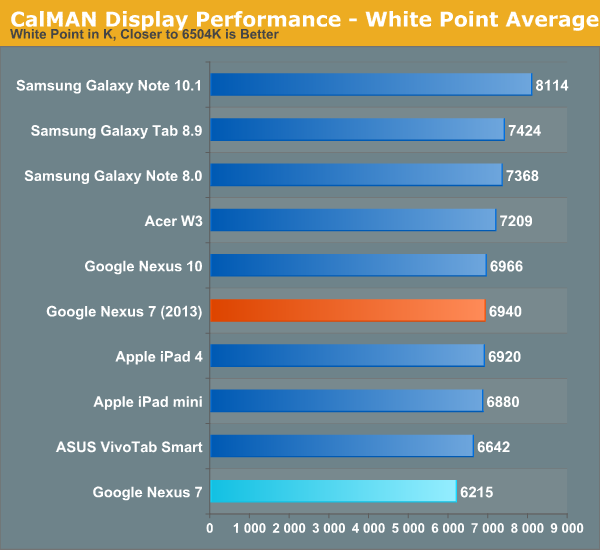
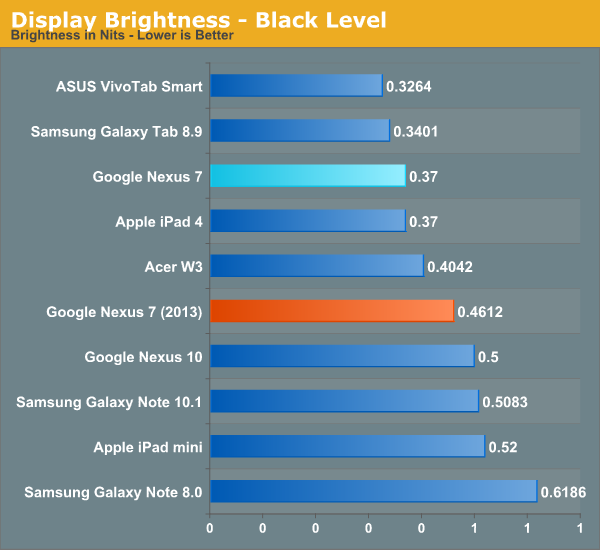
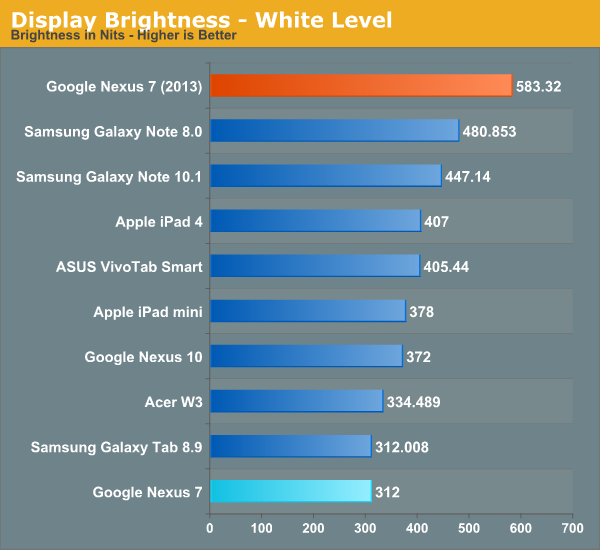
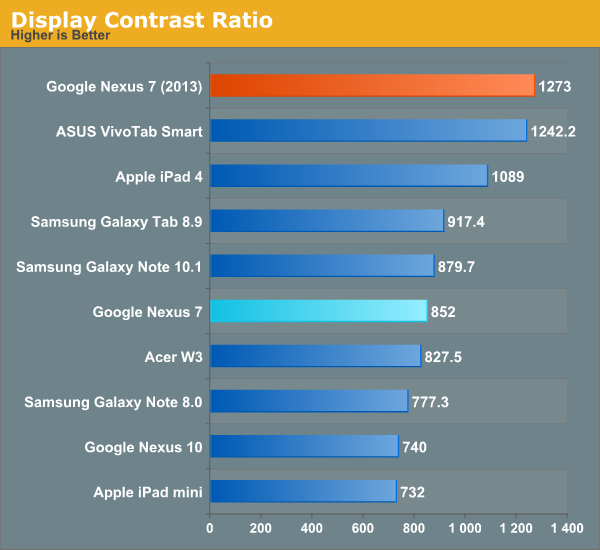
It turns out that the new Nexus 7 is actually very close to sRGB this time around, with overall gamut being just a bit bigger than the sRGB color space. In the GMB Delta-E and saturations Delta-E measures, arguably the two most relevant for color accuracy, the new Nexus 7 is second only to the iPad 4, and better than the iPad Mini in color accuracy, a significant step forwards from its predecessor.
The new Nexus 7 also goes very bright, up to 583 nits, with excellent contrast of 1273. This is again not achieved using any dynamic contrast cheating since those functions are thoughtfully disabled.
On the display side of things I’m very pleased with how far the Nexus 7 has come, and it’s obvious that display quality was a big focus for the 2013 model.















252 Comments
View All Comments
jjj - Saturday, July 27, 2013 - link
Still no microSD so not touching it but the really sad part is that this is the best and will most likely remain the best small Android tablet since everybody is focusing on budget. There is plenty of room for better specs but somehow i doubt we'll see such a product. Google should have made a high end model too,nobody else does it. Android for small tablets shouldn't be upper mid-range (like the new Nexus) or less. Everybody is making Android tablets nowadays and somehow they don't manage to cover all sizes and market segments. It's fantastic that there are decent 7 inchers at 100$ but it would also be great if there was a 7 inch tablet that's not missing anything - and that goes for all sizes.It's also nice to see that screen , such screens getting cheap enough will enable a nicer Oculus Rift :D
aNYthing24 - Saturday, July 27, 2013 - link
This is ridiculous. How many tablets do know that have replaceable memory and replaceable batteries?nerd1 - Saturday, July 27, 2013 - link
Most android tablets have micro sd slots. That said, I just dont have enough excuses not to buy this one...sherlockwing - Saturday, July 27, 2013 - link
Unfourtatedly I have to pass on this one, my Video library is 40GB+ so the lack of a 64GB model or a micro SD slot kills it for me.Sunburn74 - Saturday, July 27, 2013 - link
You watch all 40gb on a daily basis? This is a mobile device, not a media server.Broo2 - Saturday, July 27, 2013 - link
You have 40GB of videos that you like to watch on a re-occurring basis? or is the 40GB a collection of movies you have purchased that you may want to watch again? (i.e. a digital version of a shelf of DVD/Blu-Ray movies.)mr_tawan - Saturday, July 27, 2013 - link
You can just install the custom rom, plug-in a card reader in with the OTG cable. Then you can plug your media card (even CF).Well I would say setting up a media server is a lot more convenience.
Impulses - Sunday, July 28, 2013 - link
You don't even need root to use USB OTG (at least not with the original Nexus 7), much less a custom ROM, just an app... And USB OTG is far more versatile in general since you can hook up fast USB 3.0 flash drives that way, if you actually need tons of storage then you're also transferring tons of content from a PC and USB 3.0 helps immensely with that (microSD cards can't touch the 200MB/s speed of some of the cheap drives out there).I fail to see the usage case for card slots that can't be satisfied by USB OTG.
leomax999 - Sunday, July 28, 2013 - link
Would you rather carry a usb thumb drive,cables and adapters everywhere or have a microSD card in its slot?Let's try to break down. Assuming 32Gig Nexus has ~27Gigs of free space.
Couple of 1080p movies + videos = ~12G
A bit of music, Say ~10G
Some pictures ~1G
Applications + Games (No offline Maps,No big games!) ~2G
Which leaves you about 2Gig of free space which is a bit too full for flash performance, without counting any other space required for app data/cache etc.
The new Nexus is a good upgrade,But google has yet to sort the storage.
deathgod1 - Saturday, July 27, 2013 - link
I'm with you on the micro SD. I currently have a Tranformer Infinity 32GB with a 32GB SDcard and I'm constantly having to delete items off both to free up space. I don't live in a country where wifi is everywhere (or where streaming options are offered), so I keep all my media on my tab. That includes app backups with Titanium, backups of the ROM i'm using, nandroid backups, movies, music, music videos, pictures,books, comics, etc. HD games like NOVA are several GB's in size. It's really easy to run out of space if you're a media centric person like me. My tablet has basically replaced my laptop, but I guess I'm in the minority of people.